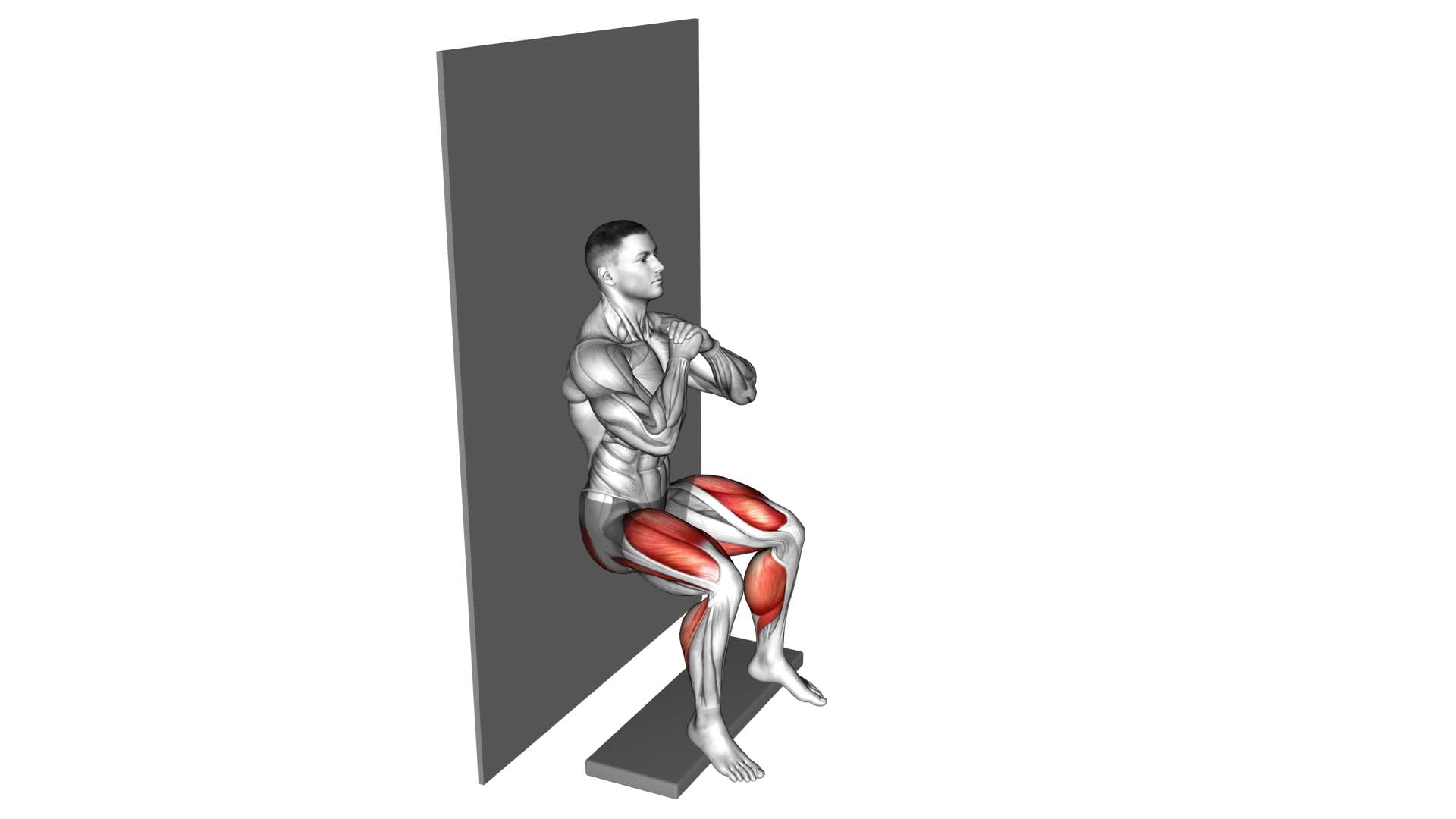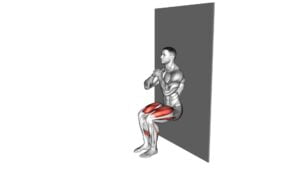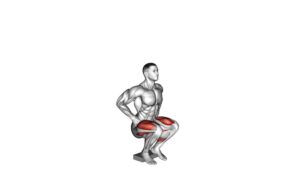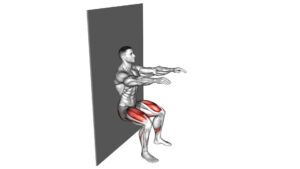Wall Sit From Deficit (Male) – Video Exercise Guide & Tips

Are you looking to level up your lower body strength?
Watch This Exercise Video
Then the Wall Sit From Deficit (Male) is the exercise for you. This video exercise guide will show you the proper form and technique to perform this challenging move.
Discover variations to increase the intensity and avoid common mistakes.
Follow our expert tips to maximize your results.
Get ready to take your leg workout to the next level with this powerful exercise.
Let's get started!
Key Takeaways
- Wall sit from deficit strengthens the quadriceps muscles and targets the muscles at the front of the thighs.
- Maintaining proper form and technique, such as keeping the back flat against the wall and bending the knees at a 90-degree angle, is crucial for maximizing the benefits of the exercise and avoiding common mistakes.
- Correct body alignment includes standing with the back against the wall, feet shoulder-width apart, toes pointing forward, and knees directly above ankles forming a 90-degree angle.
- Engaging the core muscles is essential for stabilizing the spine, maintaining correct posture, and creating a solid foundation for movement during the wall sit exercise.
Benefits of Wall Sit From Deficit (Male)
One benefit of performing the Wall Sit From Deficit exercise is that it strengthens your quadriceps muscles. This exercise specifically targets and activates your quadriceps, which are the muscles located at the front of your thighs. The Wall Sit From Deficit involves sitting against a wall with your knees bent at a 90-degree angle and your thighs parallel to the ground. This position puts a significant amount of stress on your quadriceps, forcing them to contract and work harder. As a result, your quadriceps muscles become stronger and more defined.
Additionally, the Wall Sit From Deficit exercise also helps to activate your core muscles. While performing the exercise, you need to maintain proper posture and engage your core muscles to stay in the seated position. This constant activation of the core muscles adds an extra element of difficulty to the exercise and helps to improve your overall core strength.
Furthermore, the Wall Sit From Deficit exercise is an excellent way to improve muscle endurance. By holding the seated position for an extended period of time, your quadriceps muscles are forced to work continuously, which helps to increase their endurance over time. This can be beneficial for various activities and sports that require prolonged periods of lower body strength and endurance.
To perform the Wall Sit From Deficit exercise with proper form and technique, follow the instructions in the subsequent section.
Proper Form and Technique
To perform the Wall Sit From Deficit exercise with proper form and technique, it's crucial to focus on correct body alignment, engaging your core muscles, and avoiding common mistakes.
Ensure that your back is flat against the wall, your feet are hip-width apart, and your knees are bent at a 90-degree angle.
Engage your core by pulling your belly button in towards your spine and maintaining a neutral spine.
Lastly, be mindful of common mistakes such as allowing your knees to go past your toes or rounding your lower back.
Correct Body Alignment
Ensure you maintain proper body alignment and technique while performing the Wall Sit from Deficit exercise.
Correct body alignment is crucial for maximizing the benefits of this exercise and preventing injuries.
When executing the Wall Sit from Deficit, it's important to align your body correctly to engage the targeted muscles effectively.
Start by standing with your back against the wall, feet shoulder-width apart, and toes pointing forward.
As you lower yourself into the wall sit position, make sure your knees are directly above your ankles, forming a 90-degree angle.
Keep your back straight against the wall, engaging your core muscles.
Avoid leaning forward or backward, as it can strain your lower back.
Maintaining correct body alignment throughout the exercise is essential for proper form and optimal results.
Engaging Core Muscles
Engage your core muscles for proper form and technique while performing the Wall Sit from Deficit exercise. Engaging your abs is crucial as it stabilizes your spine and helps maintain a correct posture throughout the exercise.
By activating your core, you create a solid foundation for the movement, ensuring that your lower body is properly supported. This engagement also prevents excessive arching of the lower back, which can lead to injury.
Strengthening your lower body is the main goal of this exercise, and by engaging your core, you enhance the effectiveness of the workout. Remember to breathe deeply and maintain your core engagement throughout the entire duration of the exercise to maximize its benefits and protect your lower back.
Avoiding Common Mistakes
To maintain proper form and technique while performing the Wall Sit from Deficit exercise, you need to focus on avoiding common mistakes. Here are five key points to keep in mind:
- Proper Breathing: Remember to breathe steadily throughout the exercise. Inhale deeply through your nose and exhale through your mouth to maintain a steady flow of oxygen to your muscles.
- Muscle Activation: Engage your quadriceps, hamstrings, and glutes to maximize the effectiveness of the exercise. Focus on squeezing these muscles as you hold the wall sit position.
- Avoid Leaning Forward: Keep your back straight against the wall and avoid leaning forward. Leaning can shift the workload to your knees and decrease the activation of your leg muscles.
- Don't Hold Your Breath: Avoid holding your breath as it can increase tension in your body and decrease stability. Remember to breathe continuously as mentioned earlier.
- Avoid Shallow Depth: Aim to lower yourself until your thighs are parallel to the ground. Stopping at a shallow depth can limit the activation of your leg muscles.
Variations to Increase Intensity
To further challenge yourself and increase the intensity of the wall sit from deficit exercise, try incorporating variations that target different muscles. By introducing these variations, you can increase the difficulty level and enhance muscle activation during the exercise.
One variation you can try is the single-leg wall sit from deficit. To perform this variation, start by standing with your back against the wall and your feet hip-width apart. Then, lift one leg off the ground and extend it in front of you. Slowly lower yourself into a squat position, making sure to keep your supporting leg at a 90-degree angle. Hold this position for the desired amount of time before switching legs.
Another variation to consider is the wall sit with leg raises. Begin by performing a regular wall sit from deficit. Once in position, lift one leg off the ground and extend it straight in front of you. Hold this position for a few seconds before returning your leg to the starting position. Repeat on the other side.
Incorporating these variations into your wall sit from deficit routine won't only challenge your muscles in different ways but also help you achieve a more well-rounded lower body workout. Remember to maintain proper form and engage your core throughout each variation to maximize the benefits.
Common Mistakes to Avoid
To ensure proper form during the wall sit from a deficit exercise, it's important to avoid common mistakes.
One common mistake isn't maintaining proper alignment, which can lead to inefficient muscle activation and potential injury.
Proper Form Demonstration
Avoid these three common mistakes to ensure proper form during the wall sit from deficit exercise:
- Slouching: Maintain an upright posture with your back against the wall and your knees bent at a 90-degree angle to maximize results.
- Leaning Forward: Keep your weight evenly distributed on your feet to engage your quads, hamstrings, and glutes effectively.
- Lifting Heels: Keep your entire foot flat on the ground to engage your leg muscles fully and avoid excessive strain on your calves.
- Not Breathing: Remember to breathe in a controlled manner throughout the exercise to supply oxygen to your muscles and maintain stability.
- Short Duration: To challenge your muscles and achieve optimal results, aim to hold the wall sit from deficit position for at least 30 seconds, gradually increasing the duration over time.
Importance of Alignment
Maintain proper alignment during the wall sit from deficit exercise to maximize effectiveness and prevent common mistakes.
The importance of posture can't be overstated in this exercise. It's crucial to keep your back straight against the wall and your feet flat on the ground.
This alignment helps to engage the correct muscles and target the intended areas, such as the quadriceps and glutes. By maintaining balance, you ensure that your weight is evenly distributed through your feet, reducing the risk of strain or injury.
It's also important to avoid leaning forward or backward, as this can put unnecessary stress on your knees and lower back.
Tips for Maximizing Results
Maximize your results by incorporating proper form and technique during the wall sit exercise. To ensure you get the most out of your workout, follow these effective techniques:
- Engage your core: Tighten your abdominal muscles throughout the exercise to increase stability and strengthen your core.
- Maintain proper posture: Keep your back straight against the wall and avoid rounding your shoulders. This will help target the correct muscle groups and prevent unnecessary strain.
- Control your breathing: Take slow, deep breaths to oxygenate your muscles and maintain focus.
- Gradually increase duration: Start with shorter wall sit durations and gradually work your way up. This progressive overload will challenge your muscles and promote growth.
- Add resistance: Once you have mastered the basic wall sit, you can increase the difficulty by holding a weight plate or dumbbell on your lap.
By implementing these techniques, you can maximize the effectiveness of your wall sit exercise and achieve optimal results.
Now, let's transition into the subsequent section where we'll provide you with a sample workout routine that incorporates the wall sit from deficit for males.
Sample Workout Routine Incorporating Wall Sit From Deficit (Male)
To maximize the effectiveness of your workout routine, incorporate the wall sit from deficit into your exercises.
This exercise can be added to your routine as a challenging lower body workout modification. Begin by standing with your back against a wall and your feet hip-width apart. Step forward with one foot, keeping the other foot stationary. Lower yourself into a squatting position, aiming to get your thighs parallel to the ground. Hold this position for as long as you can, gradually increasing the duration over time.
The wall sit from deficit offers several benefits. It primarily targets the quadriceps, hamstrings, and glutes, helping to strengthen and tone these muscles. It also engages the core, improving stability and balance. Additionally, this exercise can help increase lower body strength and endurance, making it an excellent addition to any workout routine.
Remember to maintain proper form throughout the exercise to prevent injury and maximize results.
Frequently Asked Questions
How Long Should I Hold the Wall Sit From Deficit Position?
To increase the difficulty of the wall sit from deficit, you can gradually increase the amount of time you hold the position. Start with holding it for 30 seconds and aim to work your way up to 60 seconds or longer.
Incorporating the wall sit from deficit into your workout routine has numerous benefits. It targets your quadriceps, hamstrings, and glutes, helping to build strength and endurance in your lower body.
Can Wall Sit From Deficit Help Improve My Vertical Jump?
Wall sit from deficit can be a beneficial exercise for improving your vertical jump. By incorporating wall sit variations into your training routine, you can target the muscles used in jumping, such as the quadriceps, glutes, and calves.
The deficit position adds an extra challenge, increasing the demand on these muscles and helping to build strength and power. This can translate to improved jumping ability and higher vertical leap.
Are There Any Specific Muscle Groups Targeted by the Wall Sit From Deficit Exercise?
The wall sit from deficit exercise targets specific muscle groups in your lower body. It helps strengthen your quads, hamstrings, glutes, and calves.
This variation of the wall sit exercise adds an extra challenge by increasing the range of motion. By doing so, it engages your muscles even more, leading to greater strength and endurance gains.
Incorporating wall sit variations into your workout routine can provide numerous benefits for your lower body strength and overall fitness.
Is It Necessary to Use a Deficit While Performing the Wall Sit Exercise?
Using a deficit while performing the wall sit exercise isn't necessary, but it can provide additional benefits. The deficit increases the range of motion, challenging your muscles even more. This can help improve your lower body strength and endurance.
The added difficulty can also enhance your stability and balance. However, if you're a beginner or have any knee or back issues, it's recommended to start without a deficit and gradually progress to using one.
Can the Wall Sit From Deficit Exercise Be Modified for Beginners or Those With Limited Mobility?
Modified variations of the wall sit can be beneficial for beginners or individuals with limited mobility. By using a chair or bench, you can decrease the depth of the squat, making it easier to perform.
Another adaptation is to perform a wall sit with a stability ball placed between your back and the wall, providing additional support.
These modifications allow for a safer and more accessible way to engage in the wall sit exercise while still reaping the benefits.
Conclusion
Incorporating the wall sit from deficit into your workout routine can provide numerous benefits for males. This exercise helps strengthen the lower body, particularly the quadriceps, hamstrings, and glutes. By maintaining proper form and technique, you can maximize the effectiveness of this exercise.
Additionally, varying the intensity and avoiding common mistakes will enhance your results. Consider adding the wall sit from deficit to your workout routine for a challenging and effective lower body workout.

Author
Years ago, the spark of my life’s passion ignited in my mind the moment I stepped into the local gym for the first time. The inaugural bead of perspiration, the initial endeavor, the very first surge of endorphins, and a sense of pride that washed over me post-workout marked the beginning of my deep-seated interest in strength sports, fitness, and sports nutrition. This very curiosity blossomed rapidly into a profound fascination, propelling me to earn a Master’s degree in Physical Education from the Academy of Physical Education in Krakow, followed by a Sports Manager diploma from the Jagiellonian University. My journey of growth led me to gain more specialized qualifications, such as being a certified personal trainer with a focus on sports dietetics, a lifeguard, and an instructor for wellness and corrective gymnastics. Theoretical knowledge paired seamlessly with practical experience, reinforcing my belief that the transformation of individuals under my guidance was also a reflection of my personal growth. This belief holds true even today. Each day, I strive to push the boundaries and explore new realms. These realms gently elevate me to greater heights. The unique combination of passion for my field and the continuous quest for growth fuels my drive to break new ground.







